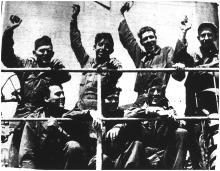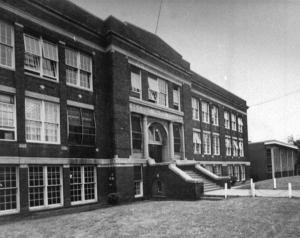You are here
G.I.'s - Home at Last
The joy of coming home can be seen on the faces of these veterans from North Carolina. Front row, left to right: Cpl. Guy R. Thornton of 2324 Chesterfield Ave., Charlotte; Cpl. Howell T. Ballard of Kannapolis; and Cpl. Robert D. Byram of 3008 Dogwood Ave., Charlotte. Standing left to right: Pvt. Judge W. Brooks of 3109 Plaza Road, Charlotte; Pfc. Bill Smith of Cramerton; Pfc. Robert W. Simril of 40 E. 9th St., Charlotte; and Pfc. Howard W. Garren of 1549 W. Trade St., also of Charlotte
However, the realities at home were often not the dream that many had imagined. There was great concern and political turmoil in the country over the slowness in which veterans returned. The military needed people willing to stay in foreign lands to patrol and rebuild a peace time economy. Friends and family, as well as the service personnel, were eager to be reunited. Even if it had been politically and militarily approved, there were not enough ships and planes to carry everyone home immediately. The war machine that had been building for almost 5 years had to be halted and turned towards a new America.
The return of the veterans caused a boom in the classrooms. Some had never earned their high school diplomas and returned to their previous schools. Others returned to their colleges, while many went to college for the first time under the G.I. Bill.
These war-weary and mature men were often out of place in classrooms with teenagers. Although their age differences were not great, their life experiences made them worlds apart in maturity. Colleges such as Davidson and Johnson C. Smith had many returning veterans as well as new students
The Charlotte College Center of the University of North Carolina started in the summer of 1946. It, as well as 11 other centers in the state, was opened by the North Carolina College Conference and the State Department of Public Instruction in anticipation of the needs of returning veterans. When it opened for the fall quarter using Central High School facilities at night, it had 276 students. Charles Bernard was the first director and he was later replaced by Bonnie E. Cone, on August 1, 1947.
The need to educate African American World War II veterans was initially met by Johnson C. Smith University. However, many returning vets had not finished high school and needed more basic education before pursuing a college program. In September of 1947, the Charlotte City School Board of Education established the Second Ward Extension School. From this initial attempt to serve students with basic skills of reading, writing, arithmetic and trades was later born Carver College.
Many service personnel brought foreign wives back home to unfamiliar surroundings. Some marriages broke up due to the distance and circumstances of the terrible times. Babies had been born to men who had never seen their children. Job and housing shortages also put marriages under strain. It was a time to adjust in almost every area of life.
More marriages resulted in more births, which brought about the phenomenon known as the “baby boom.” The increase in housing starts and other areas of growth and change would often be referred to generally as “post war.” The war not only made history - it also marked time in a cultural sense. This rapid growth resulted in the sprawl of the suburbs, the creation of new subdivisions, a need for skilled construction workers, a new plan for road expansion and eventual school overcrowding.


